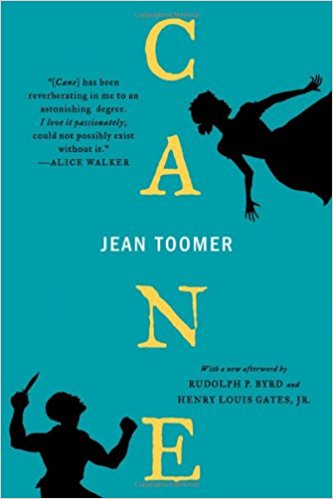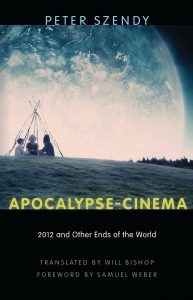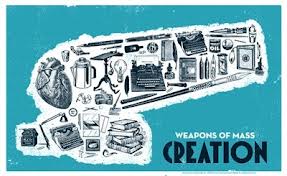Secondary Works:
Mythen, Gabe. Ulrich Beck: A Critical Introduction to the Risk Society. LONDON; STERLING, VIRGINIA, Pluto Press, 2004. JSTOR, www.jstor.org/stable/j.ctt18fs3c4.
Beck, Ulrich. Risk Society: towards a New Modernity. Sage, 2010.Tate, Andrew. Apocalyptic Fiction. London, UK ; New York, NY, USA: Bloomsbury Academic, an imprint of Bloomsbury Publishing Plc, 2017., 2017. 21st century genre fiction series.
Szendy, Peter. Apocalypse-Cinema: 2012 and Other Ends of the World. New York: Fordham University Press, 2015., 2015. College Complete.
[NEW ADDITION]Robinson, Douglas. American Apocalypses; The Images of the End of the World In Literature. Baltimore: The John Hopkins University Press, 1985.
Robert Torrey, author. “Apocalypse Then: Benefits of the Bomb in Fifties Science Fiction Films.” Cinema Journal, no. 1, 1991, p. 7.
Primary Works:
Dir. Blaustein, Julian. The Day The Earth Stood Still. Twentieth Century-Fox Home Entertainment, 1951. Film.
Cline, Ernest. “0001” Ready Player One. Broadway Books, 2015, pp. 13–26.
Robinson, Kim Stanley. “e) a Citizen.” New York 2140, Orbit, US., 2018, pp. 32–36.
Dir. De Jarnatt, Steve. Miracle Mile. Columbia Pictures and Hemdale Film Corporation, 1988.
Doctorow, Cory. Walkaway: a Novel. Head of Zeus, Tor Books, 2017.
Ellison, Harlan. “I Have No Mouth, and I Must Scream.” The Hugo Winners V2, 01 Jan. 1901.
King, Stephen. “Night Surf (1974).” American Supernatural Tales, Oct. 2013, pp. 356-364.
Dir. Trier, Lars von. Melancholia. Nordisk Film, 2011. Film.
Dir. Reeves, Matt. Cloverfield. Paramount Picture, 2008. Film.
Wells, Herbert George. The Time Machine. [Electronic Resource]. Floating Press, 2008. eBook Academic Collection (EBSCOhost).
Wells, Herbert George.. The War of the Worlds. [Electronic Resource]. Floating Press, 2008. eBook Academic Collection (EBSCOhost).
Literary Journal:
Cinema Journal published by University of Texas Press on behalf of the Society for Cinema & Media Studies.
Key Words:
- “Apocalyptic Fiction / Risk Society”
- “Post Apocalypse”
- “Genre”
- “Film Studies”
- Gender Studies?
- Apocalypse Film (Standalone)
- Ideology
My thesis idea currently stands as a more general genre study of apocalypse fiction, with possible connections to society and disaster. From the The Broadview Anthology of Short Fiction, Third Edition by Levine, LePan, and Mather, genre is defined as a class or type of literary work with different levels of generality. I intend to create a genre “map”, that is, a comprehensive study of changing ideas in current works of Apocalypse fiction literature and film. I want to discover latent links between film, television, and literature in the genre. I focuses currently on one critic, Ulrich Beck, while also on several films and novels. Beck fits my interest in the post disaster or apocalypse genre with his book “Risk Society”, which is also a concept he loosely defines as everyday risks our society takes in the name of progress, such as nuclear science disasters. Risk society sub-genres, as I like to label them, also include natural, epidemic, technological, transportation-related, and conflict-based disasters. This text is in conversation with Gabe Mythen, which may prove to be a valuable secondary source. In my discussion with Professor Malchic, we discussed films such as “Children of Men” (2006), The Day The Earth Stood Still and “Melancholia” (2011). I was drawn on my own to the short book called Apocalypse Cinema by Peter Szendy, as well as Andrew Tate’s Apocalypse Fiction for their insight into works such as these. I believe it is likely that I will need to find more critics and articles of the genre in literature or film to talk about.
For now I have framed my working thesis on: Why does the apocalypse genre always focus on “irreversible” tragedies? What does apocalypse fiction say about our current state of the zeitgeist? What are some aspects of “risk society” that have not been explored in fiction yet?
Update:
Progress in selecting my primary sources and reviewing my secondary sources has proven that I must be more specific in my approach to genre and ideology. The thesis idea now stands between two central concepts: Apocalypse and Post-Apocalypse. Post-Apocalypse is considered the genus, while Apocalypse is the sub-genre beneath it. I have made progress in answering my questions previously held questions in the reading list. Through Melancholia and Peter Szendy’s Apocalyptic Cinema came the concept of “the end” as it is placed in the narrative. However, this lead me to more questions about the conversations within the film about depression and patriarchy. These two ideologies are an example answer to my previous question: “What does apocalypse fiction say about our current state of the zeitgeist?”. This is only one example of ideology pervasive in a narrative, which I hope to further explore in novels such as Cory Doctorow’s Walkaway In Walkaway, Doctorow creates a future world in which much of the world has exiled-itself from the brutally efficient society of the ultra-rich. The exiles, or “walkaways”, attempt to create a pacifist post-scarcity civilization that prizes creativity and freedom, which becomes targeted by the zillionaires who fear their radical ideology. Where Melancholia is a classic apocalyptic film for cutting to black when the world ends, works like Walkaway have a cultural interest in post-disaster society that should be praised more in Apocalyptic cinema in addition to literature. There were another nine films and texts I chose in addition to Doctorow’s novel, Including the similarly-themed Ready Player One by Ernest Cline, which features corporate power out of control within a civilization in apocalyptic decline. The further sub-genres of apocalypse also include fantasy elements, such as alien invaders, in such works as the films The Day The Earth Stood Still, Cloverfield, and Herbert George Wells War of the Worlds (Wells also piqued my interest in The Time Machine). As seen with author of Risk Societies Ulrich Beck, sub-genres of nuclear and biological societal risks must also be accounted for with such works as the film Miracle Mile and the short story “Night Surf”, Stephen King’s precursor to his series “The Stand”. The same can be said of the Environmental apocalypse in the Global Warming wracked Manhattan in Robinson’s New York 2140 and the Artificial intelligence-themed work of Elison’s short story I Have No Mouth And I Must Scream. Biological, Nuclear, Environmental, and A.I. sub-genre works all have the potential to shed light on more potential ideological backgrounds, as well as answer whether there is a “risk society” subgenre that has not yet been explored. What else is there that has not been classified that can be called an Apocalyptic narrative? Do any of these sub-genres have American folklore or Christian Old Testament links? These questions directly lead me to seek out Douglas Robinson’s American Apocalypses; The Images of the End of the World In Literature.as another complementary secondary source devoted to defining Apocalypse. It is worth noting I found his work upon reading Susan Bower’s Beloved and the New Apocalypse. After I read several more of these works and have a clearer picture of the ideologies and sub-genres that appeal to me, I believe my project will take a more specialized form. Utilizing my knowledge in creative writing fiction, I believe it is possible my project will become a guide of sorts to understanding the ideology of the end.









